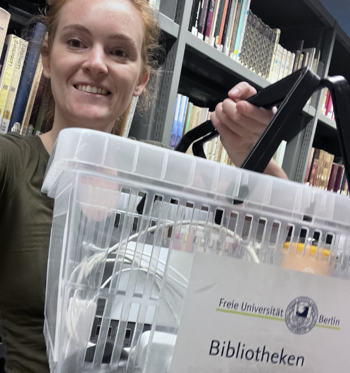Sierra Nota: Soviet Dachas and Nazi ‘Parteivillen' of Ukraine
Sierra Nota: Soviet Dachas and Nazi ‘Parteivillen' of Ukraine

My dissertation explores how the Mezhyhirya reserve, the site of an ancient Cossack monastery on the outskirts of Kyiv, became a haven for Imperial, Soviet, and post-Soviet leaders to imagine their political goals and (literally) destroy those of their predecessors. I am also working on an article project on the Museum-Archive of the Transitional Age in Kyiv, a brief venture in 1942 that represented a collaboration between Ukrainian academics and Nazi occupiers to justify and reframe the Reichskomissariat Ukraine. For both of these projects, I knew that the physical NSDAP archives located in Berlin were indispensable sources. Among some of the more interesting documents that I found in the archive were meeting minutes where Nazi propagandists debated the efficacy of Ukrainian-led projects, planning documents for the clearing of land for recreational hunting by members of the Nazi apparat around Mezhyhirya in 1942, and an interview conducted with a former groundskeeper of an estate at Mezhyhirya.
I spent approximately three days each week at the Berlin branch of the Bundesarchiv, or Federal Archive, in Lichterfelde, where I worked with both microfilm and physical documents. For each of the hundreds of documents that I requested and viewed, the archive presented me with a streamlined process to request, obtain, photograph, and process every file. I will miss my walks through the stunning campus of the archive, lunches and casual conversations in its colossal lobby, and long hours spent pouring over archival materials.
During any days when I did not go to the archive, I would instead head to the Free University. I could even take the train to the same S-Bahn stop, Lichterfelde-West, for both locations, making for a stress-free commute. I was invited by Dr. Robert Kindler, a history professor at the Free University, to spend my summer as a visiting scholar at the Free University’s Institute for East European Studies, or “Osteuropa-Institut”. This allowed me access to the library collections, faculty, and events held by the institute. I became an expert at searching the university’s “primo” catalog for its immense wealth of German-language journals, monographs, and newspapers, many of which I was able to view in person at the Osteuropa library on Garystraße. I really enjoyed immersing myself in campus life, and I often spent early mornings before the library opened walking through the campus or getting coffee at the Mensa.
One of the privileges of being at visiting scholar at the institute was the invitation to present at a joint colloquium held by FU-Berlin and Humboldt University, the ‘Berliner Kolloquium zur Geschichte Osteuropas,’ or Berlin Colloquium on East European history. I presented a chapter in progress from my dissertation, furnished in part from sources I had collected while in Berlin from the Bundesarchiv. With about thirty-five other scholars, I workshopped this chapter, titled “Forefathers of Yanukovych: The Soviet Dachas and Nazi ‘Parteivillen' of Ukraine, 1934-1952” on July 20th, 2022. It felt very special to see many familiar faces here, both from Berlin and from previous conferences, and to collect their suggestions for my work. This was the real highlight of the trip for me, as it embedded me firmly in the rigorous but welcoming academic network of Berlin.
Perhaps the other highlight was my half week trip to Koblenz in mid August, where I spent a few days at the main branch of the Bundesarchiv. I had to travel to Koblenz to view a few documents related to a summit that was held between Helmut Kohl and Mikhail Gorbachev in 1991 on the territory of the Mezhyhirya reserve. This summit will be a small part of the final chapter of my dissertation, on the dissolution of the Soviet Union and post-Soviet Mezhyhirya. The network of Inter-City and Inter-City Express trains that I took to get between Berlin and Koblenz allowed me to see many different parts of Germany out the windows of my Deutsche Bahn train. In the city of Koblenz itself, with its fortresses and hills at the confluence of the famous “Deutsches Eck,” the ‘German corner’ where the Mosel River meets the Rhine, centuries of well-preserved German history and architecture are visible any way you look. It was a real treat to be able to visit Koblenz during my trip, and to have the time and funding to make this opportunity possible.
Prior to this trip, I had never imagined that I would be able to live in Berlin. My archival research has thus far taken me on extended trips to Ukraine and Russia. Owing to the war, many sources and archives that I have gotten to know as a historian have since become inaccessible. I am deeply grateful for the opportunity to look for sources in Berlin, and very excited by what I found while I was there. Not only did I work here, but I also made a new home for myself in Schillerkiez, a Berlin neighborhood in the Neukölln borough. My days at the archive or library were punctuated by sunny afternoon concerts at Tempelhof field, two-Euro falafels, and sprints to Boddinstraße station to catch the U8 to dinner, spin class, or a vintage shop in Kreuzberg. I am endlessly grateful to the Europe Center and the Stanford Club of Germany for allowing me to live and learn in this amazing city.
